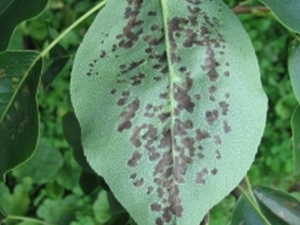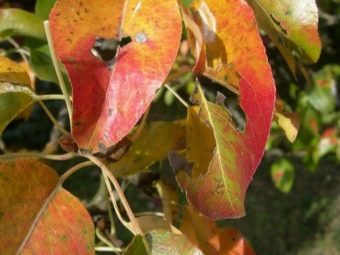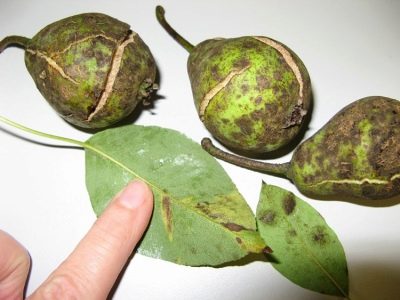Diseases of pear leaves and their treatment

On any garden plot you can see such a fruit crop as a pear. With proper care, trees are able to give their owner many sweet fruits and positive impressions. Caring for them is a painstaking but interesting occupation. There is a problem that can darken all the good sides of the pear growing process. There are many diseases that degrade the decorativeness of trees, as well as reduce their productivity.
Due to numerous viruses, the pear may die. Therefore, you need to monitor the development of the tree in time to see the first symptoms of the disease. If the leaves wither, and the flowers do not bloom - it means you need to start using special preparations.
Problems and causes
To understand what problem the gardener has encountered, it is necessary to carefully consider the symptoms that have appeared on any parts of the plant.
Blush leaves
Most often, red leaves, on which you can see black and brown dots or bumps, appear on the pear in autumn. They are located at the top of the plant. There may be several reasons for these consequences.
- The tree may lack phosphorus. If this is true, the disease begins from the bottom of the sheet.
- Waterlogging. It is necessary to ensure that the various waters obtained by means of precipitation and soil do not stagnate, as well as implement the correct irrigation regime. Due to the large amount of liquid the tree lacks oxygen from the root system, this makes breathing difficult, the roots begin to soak up. Subsequently, the plant will not be able to resist frost.
- Stock and graft are incompatible. When the cause is this fact, the sapling will have not only red leaves, but also swimming in the place of budding. Seedlings need to be replaced.
Orange or red spots
Gardeners who are not very experienced can panic if, in June, rust-colored patches of stains are found on the leaf plates of the plant. The cause of these symptoms is a fungal disease called rust. It may appear because of the juniper, which is often grown in gardens. The pathogens are there in the winter, and in the spring they are transferred to a tree.
At the beginning of the growing season, the leaf plates of trees suffer greatly, and in June one can see seals in the back of the leaves, in which there are fungal spores.
If you take this disease seriously, the trees may die. Rust can negatively affect not only the leaves, but also the fruits, as well as the shoots.
Chlorosis
If pale spots of yellow color are seen on the leaf plates, it means that the gardener has encountered plant chlorosis. Soon the leaves turn completely yellow. The process begins on top of the tree. At first the leaf loses its color, becomes light, and then yellow. If you start a disease, it will progress and contribute to leaf death. They wither, dry, and then fall off.
Chlorosis occurs when there is not enough iron in the soil. In order for the plant to develop normally, one should enrich the earth and the tree with this element.
Scab
If black leaves appear on the leaves of a fruit tree or they turn brown and can later lead to their falling off, it means that the plant has become infected with a scabies fungal disease. If you do not treat the disease, it can affect young shoots that will die soon after infection. The bark begins to peel off, crack and swell. If a tree is attacked by a scab, the development of the ovaries stops. The fruits also turn black and fall off. The pulp of the fruit in the affected areas is hard, growths can be formed.
The disease is able to hit a variety of areas of the plant, including flowers. In winter, the pathogen is found in the leaves that have fallen before, as well as in young fruits and shoots.
Bacterial burn
Some gardeners can not understand what to do if the leaves begin to darken and curl. Because of this, all methods of struggle are meaningless, and the disease progresses. Leaf curl and dark brown spots are a symptom that speaks of a disease called a bacterial burn. Leaf plates may look burnt. Many may think that the disease is similar to sunburn, but it is not. The causative agent is a bacterium carried by birds and the wind.
The initial stage of the disease is not very pronounced. First, the bacteria are in flower stalks, which subsequently do not develop, wither and die. Soon the burn moves to the top of the trees, causing the leaves to turn black and curl. The disease develops quite quickly, which is why the first signs may not be too noticeable. The disease can begin due to wet and warm weather. Precipitation falls without a decrease in temperature, which creates a greenhouse effect, which is a good condition for activating pathogens. Most often trees are affected up to ten years. They are young, have weakened immunity and active movement of juice.
Plants growing eleven years old and more are more resistant to a bacterial burn.
What are dangerous?
The diseases mentioned earlier are extremely dangerous for pears. Leaf disease is something that can cause serious harm to both the health of the tree and the crop. Due to the fact that the plant will not receive the necessary nutrients, it may weaken. Also, due to various fungal diseases, the leaves fall off and dry out, there are no ovaries, flowers are dying. If the leaves are curled into a tube and are sticky, then you should use special tools.
If you do not eliminate the disease and treat this problem carelessly, the tree may disappear. The yield will be low, the fruits will lose their taste and presentation, may also be completely absent.
In order to prevent such a scenario, you should pay attention to the pronounced symptoms in a timely manner and eliminate the infection.
Remedies
To get rid of rust, remove all areas of the tree that have been infected. Branches must be cut 10-15 centimeters below the infected area. Next, you need to clean the cut with a knife to uninfected wood. It is also important to treat the wounds with a five percent solution of copper sulphate. This will help to disinfect the place. After it is processed by garden pitch. In May, the tree must be treated Bordeaux liquid (one percent solution). But it can be replaced by copper oxychloride.
The second time the plant is processed during the flowering period, and then - a week after it. After 10 days, the last treatment is carried out.
How to get rid of other diseases.
- If the pear has undergone a scab attack, in September it should be treated with Nitrafen and Dnock.
- If the leaves turn black, you need to use the insecticide Calypso. It will help get rid of vectors of diseases and a variety of insects.
- The spread of the fungus can stop the Fitover fungicide.
- The pear is saved from powdery mildew by the timely removal of infected branches and leaf plates. They need to be burned so that the infection is not transferred to other trees. From such a disease, Fundsol and Sulfite are quite effective.
- If a tree gets sick with a bacterial burn, it is necessary to get rid of diseased branches. You should grab 10-15 centimeters of living tissue so that the disease does not progress.
- Many gardeners use a simple and reliable way to treat trees. The wounds of pears are lubricated with a special solution. Three tablets of rifampicin or gentamicin must be dissolved in a liter of liquid and carefully treated each wound. If something remains, you need to spray the whole plant.
- To save the tree from chlorosis, it is necessary to enrich the soil and the plant itself with a necessary element.If the gardener notices the first signs of the disease, you need to spray the tree with iron sulfate or products that contain iron. It is also worth taking care of the soil under the plant. It should be dug over, then iron-containing preparations are placed there in a liquid form. One hundred grams of ferrous sulfate should be dissolved in ten liters of water, and then water the tree.
- If the lower leaves of a tree suffer the most, there is a shortage of nitrogen. It is necessary to feed the plant with urea. For this, 30-35 grams of urea is dissolved in a bucket of water. You can use another method. The ideal option for nitrogen fertilizing is humus. It should be introduced into the root zone of the plant.
- If the leaf plates become yellow between the veins, then the tree lacks zinc. It is necessary to spray the plant with means of zinc sulphate (25 grams per bucket).
Prevention and care
To prevent the spread of rust, you should get rid of juniper, if it grows next to the tree. If the gardener has noticed the first symptoms of the disease, it is necessary to remove all the damaged leaves, and also to collect the dry ones on the soil. This garbage must be burned, but not on the site. Fungal diseases multiply well, if the humidity is high. In this regard, when watering the plant, you need to ensure that the liquid does not fall on the leaves.
If it rains constantly in summer, it is necessary to spray the wood with Bordeaux liquid. This will help the plant to fight diseases. The first treatment is carried out in March, the second - in the middle of summer. If the juniper is still near the pear, it is necessary to process it. Sick shoots and old needles are removed, spraying is carried out. Such preventive measures will help protect the pear from various diseases and insect attacks.
Scab - a disease that most often can occur due to too thick plantings or poor pruning of plants. It is necessary to ensure that the crown of the tree is not very thick, as well as to timely remove the shoots growing inside. As with other diseases, treating trees with Bordeaux liquid is an effective preventive measure. It is important to remember that after the flowering period, only a one percent solution of this product can be used, otherwise burns on the leaf plates may occur.
Useful tips
Any experienced gardener remembers that a pear is a tree that needs significant watering. This is especially important for people living in regions where natural precipitation is categorically insufficient for the normal development of plants. If the weather is hot and dry, it is necessary to water not only the root system, but also the branches, sprinkling and refreshing them. The tree is able to independently be supplied with moisture only in the fifth or seventh year of life, so you need to carefully monitor the mode of watering. Otherwise, the tree will become weak, lose its immunity and be at risk of getting any virus.
When fruits begin to appear on a plant, it becomes more resistant to both adverse factors and various diseases and pests. Before it begins to bear fruit, it is important to take good care of the tree, because only in this way it will be able to guarantee fast growth and future production of juicy and large fruits.
For good disease resistance and proper development, plants should be watered several times a month. The soil should be wetted by fifty to seventy centimeters.
To the approximation of frosts should insulate the roots of trees. The soil is mulched with peat, straw or ash. The trunk must be whitened, as are the bases of the skeletal branches. This will help to cope with parasites. Adult pears are more resistant to frost than young seedlings. In this regard, you need to take care of shelter for young plants. You can lapel them with lapnik, put burlap, paper or spandbond on top.The whole structure should be well secured with ropes or wire.
When snow falls, you need to rake it to the root system and gently lay in the form of a snowdrift around the trunk. If the snowfall is heavy, the gardener should get rid of the snow on the branches, shaking it off. If the branches are overloaded, they can break off. Mild winters allow those who grow pears to relax, as for their warming it will only be necessary to mulch the near-stem circle.
For pear diseases and methods for their treatment, see below.







































